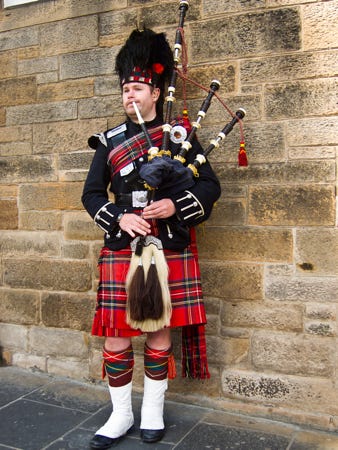
RASHI, RAMBAM and RAMALAMADINGDONG
A Quizbook of Jewish Trivia Facts & Fun

A Quizbook of Jewish Trivia Facts & Fun
Parliamentary elections were held last week in Scotland, with a major issue being the possible move toward independence from Great Britain. The drive for independence has grown much stronger since Great Britain decided to leave the European Union. Pro-independence parties gained a majority of seats in the election, and the largest party, the Scottish National Party, has stated that they will hold a national referendum on the issue. Jews have been in Scotland since at least the 17th century, and the Jewish population grew to more than 20,000 after World War II. However, at this time it is estimated that there are only about 6000 Jews remaining, centered primarily in the cities of Glasgow, Edinburgh, and Dundee. Rabbi Mendel Jacobs of the Lubavitch of Scotland is known for what action that related to traditional Scottish culture?
Edinburgh Piper by David Blaikie is licensed under CC BY 2.0
A. Rabbi Jacobs ruled that Jewish men are not allowed to wear tartan kilts, the traditional Scottish clothing. He based his ruling on Deuteronomy Chapter 22 Verse 5, “A woman must not put on man’s apparel, nor shall a man wear woman’s clothing; for whoever does these things is abhorrent to the Lord your God.”
B. Rabbi Jacobs ruled that Jewish men are only allowed to wear tartan kilts, the traditional Scottish clothing, if it has his rabbinical certification. He based his ruling on the shaatnez prohibition, wherein Jews are not allowed to wear clothing that combines wool with linen. Jews can bring their kilts to the Rabbi for inspection. If he determines that the item only contains wool, he stamps the clothing with a kashrut certification symbol similar to the kosher O-U symbol. However, in this case the symbol is a letter L in a circle (for linen), with a red diagonal line through the L. Jews entering Rabbi Jacobs’ shul wearing a kilt must show the O-L stamp to the synagogue gabbai for approval before being allowed in.
C. The Jacobite is a steam engine train, part of the Scottish West Highland Railway Line, that travels through the Scottish Highlands and is very popular with tourists. The train was used in many of the Harry Potter movies and presented as the Hogwarts Express. Rabbi Jacobs has declared that Jews are not allowed to ride the train, as the association with the name Hogwarts renders the train unkosher. He said this is based on the principal of marit ayin which states that things that are technically kosher but appear to violate the law are therefore deemed unkosher.
D. Rabbi Jacobs created a kosher tartan, the traditional Scottish cloth consisting of criss-crossed horizontal and vertical bands, representing clans in Scotland. His tartan design includes blue and white for the Israeli and Scottish flags, gold for the golden items in the Biblical tabernacle, silver representing the silver decorations on a Torah scroll, and red symbolizing kiddush wine. The tartan design can be purchased in the form of a kilt, necktie, mouse pad, yarmulke, and a tallit.
E. Rabbi Jacobs moved to Scotland in 2017, and soon after he noticed that the name of Scotland’s national poet, Robert Burns, appeared on signs as Rabbie Burns (which is the traditional Scottish spelling). Misinterpreting that the famed poet was actually a rabbi, Rabbi Jacobs held a celebration for the local Jewish community on Burns Day, the poet’s birthday, where he served a dinner of kosher haggis, the traditional dish of sheep’s heart, liver and lungs, onion, oatmeal, suet, spices, and salt, cooked inside the sheep’s stomach. Said Rabbi Jacobs, “If we can eat kishka, why not eat haggis like Rabbi Burns?”
✡ ✡ ✡ ✡ ✡ ✡ ✡ ✡ ✡

© 2025 MMJZ Services, Inc.